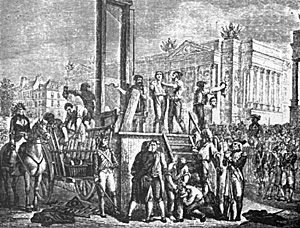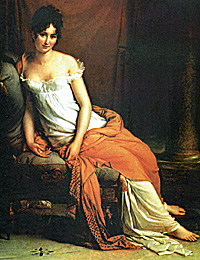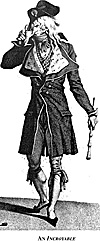 On July 27, 1794 or the 9th of Thermidor of the Year III of the Republic, Robespierre was placed under arrest by Barras and his troops. He was summarily tried and guillotined the next morning on July 28. That event marked the end of the Terror. The more liberal Directory succeeded Robespierre's dictatorship.
On July 27, 1794 or the 9th of Thermidor of the Year III of the Republic, Robespierre was placed under arrest by Barras and his troops. He was summarily tried and guillotined the next morning on July 28. That event marked the end of the Terror. The more liberal Directory succeeded Robespierre's dictatorship.
With the Directory, reason slowly prevailed and basic freedom quickly returned. Along with the first pacification of the Vendee, the next few months witnessed an unprecedented explosion ofjoy and gaiety, a happy-go-lucky attitude and a new wave of libertinage which tended to match that of the defunct French court which had been swept away by the Revolution and the mass emigration of the nobles. As they slowly returned to France, the latter did not recognize their country. They felt as if they were in a foreign land.
In Paris, the release of the Prairial Law prisoners was celebrated by people of all classes. There were balls in the houses of the rich and influential, including some nobles who again began appearing in public. Parties were held in the streets, warehouses, and armories for the common people. There were no less than 300 ballrooms in Paris. "Victims Balls" became the rage. To put some spice in the festivities, a few gruesome reminiscences were particularly appreciated. It was sufficient for a pretty lady who had lost a relative to the guillotine to wear a wax mask and a blood-red ribbon around her neck - on the right space - (all that reminiscence of the now defunct guillotine) to be an instant success.
 Freed from the puritan regulations of the Terror, Paris society became increasingly licentious. The salons once more flourished. The most popular was that of Therese Cabarrus who shortly became Madame Tallien, styled by a bawdy admirer "Our Lady of Thermidor". She was the daughter of Franqois Cabarrus, a French banker with a Spanish title and fortune in both countries, and herself the divorced wife of a French marquis. Imprisoned in 1793 at Bordeaux, she was saved and taken back to Paris by Tallien, a representative-in-mission. In Paris she was imprisoned again but released after Thermidor. In jail she had met Josephine de Beauharnais, the widow of the General (Viscount) de Beauharnais who had been guillotined in 1794. She secured the release of Josephine, the future wife of Napoleon.
Freed from the puritan regulations of the Terror, Paris society became increasingly licentious. The salons once more flourished. The most popular was that of Therese Cabarrus who shortly became Madame Tallien, styled by a bawdy admirer "Our Lady of Thermidor". She was the daughter of Franqois Cabarrus, a French banker with a Spanish title and fortune in both countries, and herself the divorced wife of a French marquis. Imprisoned in 1793 at Bordeaux, she was saved and taken back to Paris by Tallien, a representative-in-mission. In Paris she was imprisoned again but released after Thermidor. In jail she had met Josephine de Beauharnais, the widow of the General (Viscount) de Beauharnais who had been guillotined in 1794. She secured the release of Josephine, the future wife of Napoleon.
Therese and Josephine (called "Rose" by her friends) set the fashion for Paris, where the basic dressy dress was the flowing "Greek" gown of diaphanous material that revealed the bust. That type of dress, soon became the standard fashion of the Les Merveilleuses (or Marvellous Ones).
But Madame Tallien and Josephine were displaced as reigning beauties by their seventeen-year-old friend, Madame Recamier, a sylph of such perfection of figure and face that artists fought to do her portrait and men of all position were made her slaves by a glance.
[1]
Their female companions, Les Merveilleuses (or Marvellous Ones) wore dresses of the Greek style in the fashion launched by Mesdames Tallien and de Beauharnais (Josephine). These dresses were made of light gauze which did not hide very much of their beauty. The fashion was set on transparency, to the sincerity of the Greek statues and the waist now brought back under their breast allowed the women of fashion, on the Champs-Elysees and Luxembourg [2] , to put their upper abdomen in prominence. The offended dowagers had probably forgotten that the moral standard of their youth was probably as relaxed as it was now. Perhaps, in their time, courtship was more formal, but, by now, the lightness of dresses encouraged, let us say, quicker but not as romantic encounters. [3]
Madame Tallien and Josephine introduced the Merveilleuses to hairpieces and pastiches. So, now, the color of a women's hair could change several times a day. Les Incroyables wore on their enormous ties their little royalists heads.
However, at times, the Golden Youth were very aggressive and these angry young men flaunted their wealth, which they had been forced to hide for so long from the masses, and both offended people. They harassed the sans culottes but their main target were the ex-terrorists and especially the Jacobins (Robespierre's supporters). In fact, it was Les Incroyables who set the stage for the destruction of the Jacobins. Their Paris club had been closed on the 10 Thermidor (i.e. after Robespierre's fall) but reopened the next day for "honest Jacobins" (i.e. anti-Robespierrists). A few days later, a mob of Incroyables led by Freron (a former terrorist but clever turncoat) invaded the club, assaulted its members, destroyed the furniture and left the place in a shambles. The next day, the Convention ordered the club closed permanently.
In spite of that, all that new wave, when not violent, lived happily ... The paper money had lost most of its value, but the Parisians, after the Terror, could not care less, they danced! They had rediscovered liberte and libertinage went hand in hand! Madame Hamelin, another famed socialite, wagered that she would go from the Luxembourg' to the Champs-Elysees bare breasted and won her bet ....
During this period, the Directors and many other high ranking officials gave their official acceptance of the easy life by openly indulging themselves in corruption and debauchery'. Then Bonaparte, successively First Consul, Consul for life, then finally Emperor in 1804, (in the political sense) put the house somewhat in order. However, during the time his soldiers covered themselves with glory, the joyous life continued. His relatively mild dictatorship never penetrated the day to day life nor the bedroom and its intimacy. The Emperor of the French never became the Emperor of the French women .... But that is another story.
[1] Juliette Recamier, in spite of appearances, was probably the least immoral of the socialites. Madame Tallien and Josephine were not models of virtue. Between 1794 after she was released from prison and the time she married Napoleon, Josephine was at various times mistress to Directors Tallien, Gohier and Barras. After marrying Napoleon in March 1796, she riskily continued flirtation with other men and the future Emperor almost divorced her for infidelity in October 1799.
 The streets were taken over by the dandies of the period, Les Muscadins or Incroyables (or "Incredibles"). The "Gilded Youth" sons of the rich illustrated the new trend. They wore pantaloons, tight-fitting with red-white-blue stockings, long skirted, colored coats and cravats that rose in six folds to meet their shaggy, uncombed, greasy but perfumed hair that covered the ears. Fashion dictated that the clothes be rumpled and the boots muddy.
The streets were taken over by the dandies of the period, Les Muscadins or Incroyables (or "Incredibles"). The "Gilded Youth" sons of the rich illustrated the new trend. They wore pantaloons, tight-fitting with red-white-blue stockings, long skirted, colored coats and cravats that rose in six folds to meet their shaggy, uncombed, greasy but perfumed hair that covered the ears. Fashion dictated that the clothes be rumpled and the boots muddy.
ENDNOTES
[2] The Luxembourg was the residence of the Directors and its famous gardens was one of the Parisian's fashionable hangouts.
[3] See note 1 for the relationship of three of the Directors with Josephine and that is just the tip of the iceberg!
Back to Empire, Eagles, & Lions Table of Contents Vol. 2 No. 5
Back to EEL List of Issues
Back to MagWeb Master Magazine List
© Copyright 1994 by Emperor's Headquarters
This article appears in MagWeb (Magazine Web) on the Internet World Wide Web.
Other military history articles and gaming articles are available at http://www.magweb.com
